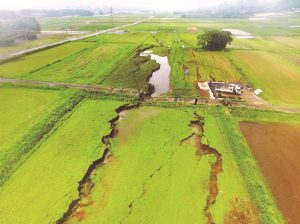
Credit: Image courtesy of Kyoto University
Damage from the 2016 Kumamoto earthquake could hasten Mt. Aso’s eruption, volcanologists warn. In a paper published on Science, Kyoto University researchers and colleagues report new faults in the vicinity of Mt. Aso’s magma chamber and volcanic cones, which they say could alter spatial and mechanical properties of Aso volcano.
Mt. Aso is one of the largest active volcanoes in the world. The 16 April 2016 Kumamoto earthquake, study authors say, were a rare opportunity to study how faults form in the vicinity of volcanoes. “Our survey group went to the epicenter area one day after the event and continued field work for the past half year after the earthquake,” says Aiming Lin of Kyoto University, who led the study.
The Kumamoto earthquake enabled the researchers to do a before-and-after comparison of fault distribution in the area. Field investigations, seismic data, and analysis of high-resolution Google earth images show that the earthquake produced new faults and surface ruptures.
Some of these cut Aso caldera but terminated there.
“Magma is fluid so it absorbs stress. That’s why the damage — the co-seismic rupturing — shouldn’t travel any further,” says Lin. “Large earthquakes often accompany or precede volcanic eruptions. The presence of magma does have an association with the distribution of active faults. But whether volcanoes affect the fault rupturing following an earthquake remained unclear due to the lack of case studies.
“Our findings show that propagation of ruptures from this earthquake terminated in Aso caldera because of the presence of magma beneath the Aso volcanic cluster.”
The newly formed co-seismic ruptures under Aso caldera are potential new channels for magma venting, thus changing the physical dynamics of Aso volcano, such as where pressure is concentrated. These then influence factors like the nucleation of interpolate earthquakes, seismicity patterns, source rupture processes, strong ground motion and recurrence behavior of fault segments. The study results, the authors wrote, could play an important role in reassessing volcanic hazard in the Aso volcano area.
And Mt Aso did erupt 8th October 2016, after the research team had submitted the paper.
“We are surprised that Aso volcano erupted after a 36 years dormant duration, as we documented in this paper that the new faults changed the spatial and mechanical dynamics of Aso volcano,” says Lin.
Reference:
A. Lin, T. Satsukawa, M. Wang, Z. Mohammadi Asl, R. Fueta, F. Nakajima. Coseismic rupturing stopped by Aso volcano during the 2016 Mw 7.1 Kumamoto earthquake, Japan. Science, 2016; DOI: 10.1126/science.aah4629
Note: The above post is reprinted from materials provided by Kyoto University.









